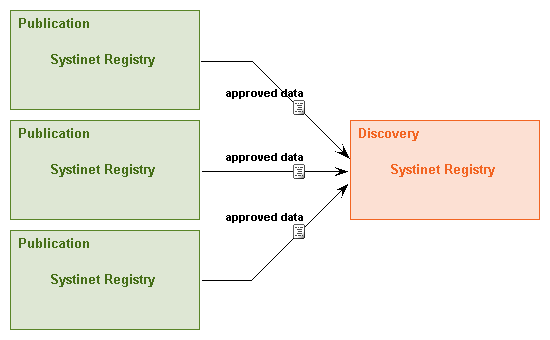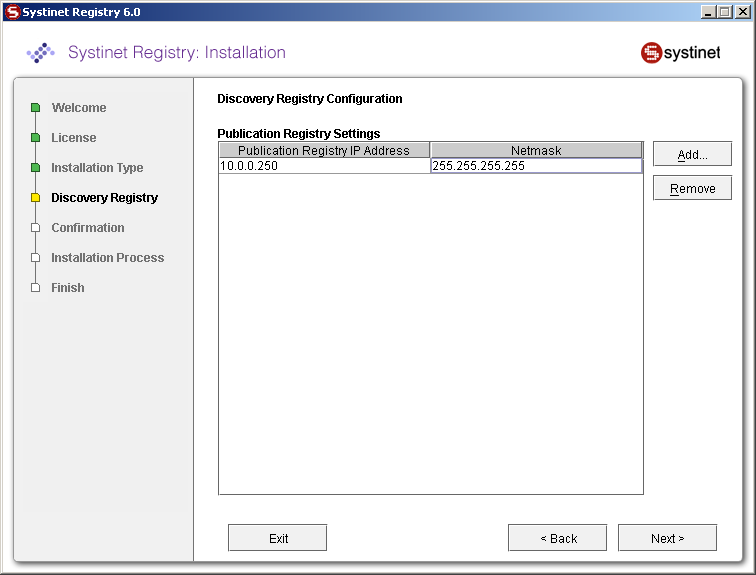Approval Process Registry Installation Locate
BEA AquaLogic Service Registry allows for installation with an approval publishing process which requires two registries: a publication registry and a discovery registry. The publication registry is used for testing and verification of data. The discovery registry contains approved data that has been promoted from the publication registry.
BEA AquaLogic Service Registry supports the following scenarios of approval process configuration:
One publication and one discovery registry as shown in Figure 26. This is the simplest configuration. Data is promoted from the publication to the discovery registry after an approver approves the data.
Multiple publication registries as shown in Figure 27. Promoted data is merged from more than one publication registry to a single discovery registry.
Multiple step approval process as shown in Figure 28. There can be many steps for promoting data from the publication to the discovery registry. For example, you can define the approval process to include two steps of data promotion. The first step is promoting data from a 'unit testing' registry to an 'integrated testing' registry. The next step is promoting data from the 'integrated testing' registry to a 'production quality' registry. In this case you need to install three registries as shown in Figure 28. See Intermediate Registry Installation to learn how to install a registry that behaves as both publication and discovery registry.
We recommend that you install the discovery registry first, and then the publication registry, because the digital security certificate of the discovery registry is needed when installing the publication registry.
![[Important]](../images/important.gif) | Important |
|---|---|
To install the publication or discovery registry with accounts in external storage you must ensure that accounts from the publication registry are a subset of accounts on the discovery registry. Accounts may exist on the discovery registry that do not exist on the publication registry, but all accounts on the publication registry must exist on the discovery registry. Put another way: all accounts on the publication registry exist on the discovery registry, but not all accounts on discovery registry exist on the publication registry. It is also not allowed to have two different LDAP servers, one for the publication registry and one for discovery registry. For more information about setting of external accounts, see the External Accounts Integration chapter in the Installation Guide. | |
![[Note]](../images/note.gif) | Note |
|---|---|
Do not forget to configure the SMTP configuration on the publication registry for receiving email notifications. | |
To learn more about the approval process, see the Approval Process chapter in the Administrator' Guide.
Discovery Registry Installation Locate
To install the discovery registry, install it as described in Installation. At installation, during installation type selection, choose Discovery instead of the default Standalone installation.
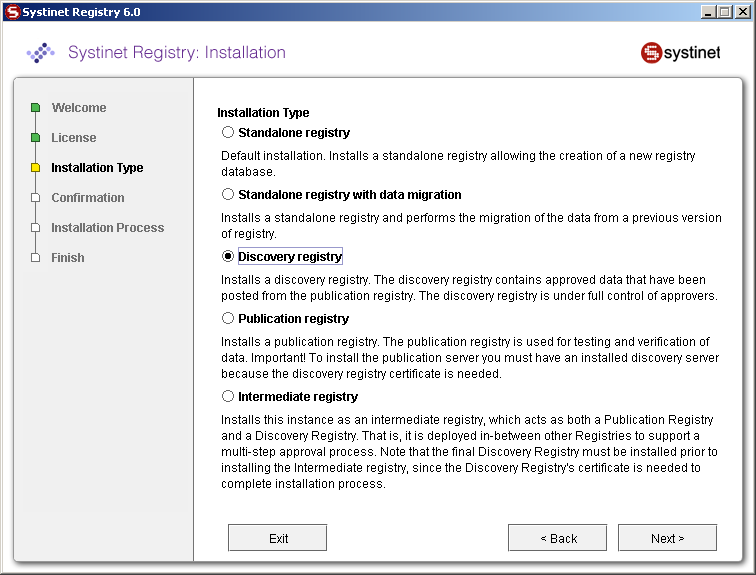
Fill in all properties on the discovery-specific panel shown in Figure 29
Set the following properties:
- Publication Registry IP address
The IP address allowed to connect to this discovery registry .
- Netmask
A netmask is a 32-bit mask used to divide an IP address into subnets and specify the network's available hosts.
The default netmask of 255.255.255.255 indicates that publication registry may be connected only from the IP address specified in Publication Registry IP address
Continue with standalone installation as described in Server Settings.
Publication Registry Installation Locate
![[Important]](../images/important.gif) | Important |
|---|---|
To install the publication registry you must have an installed discovery registry as described in Discovery Registry Installation. | |
Install the publication registry in same way you would the Standalone registry as described in Installation. During installation selection, choose Publication instead of the default Standalone installation.

Fill in the properties shown below:
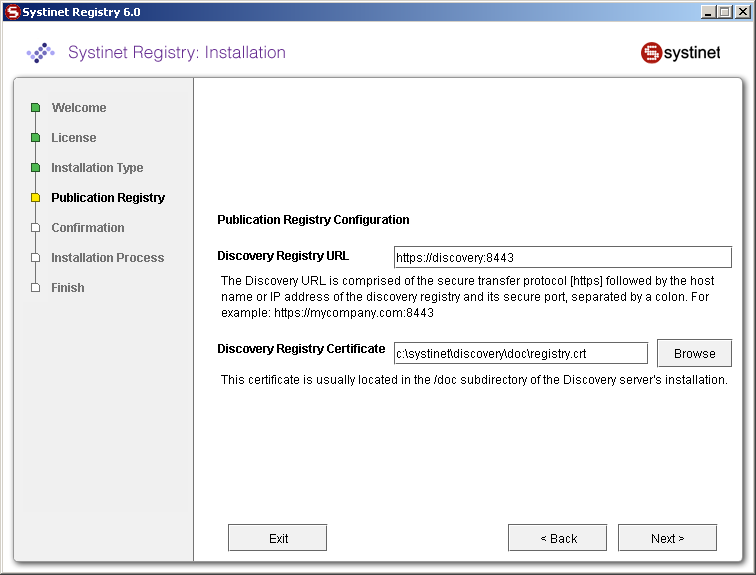
- Discovery Registry URL
Enter the HTTPS URL of the discovery registry. Note that HTTP (nonsecure) connections between the publication and discovery registry are not allowed.
- Discovery Registry Certificate
Browse for or type the fully qualified path to the certificate file from Discovery Registry. This file is located on the discovery installation directory at REGISTRY_HOME/doc/registry.crt.
Continue with standalone installation as described in Server Settings.
Intermediate Registry Installation Locate
Install the publication registry in same way you would the Standalone registry as described in Installation. During installation selection, choose Intermediate instead of the default Standalone installation.
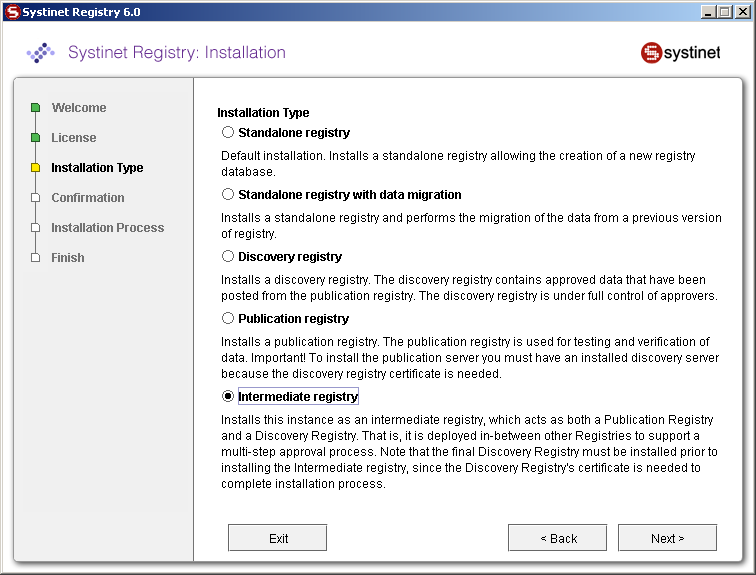
Fill in the properties shown below:
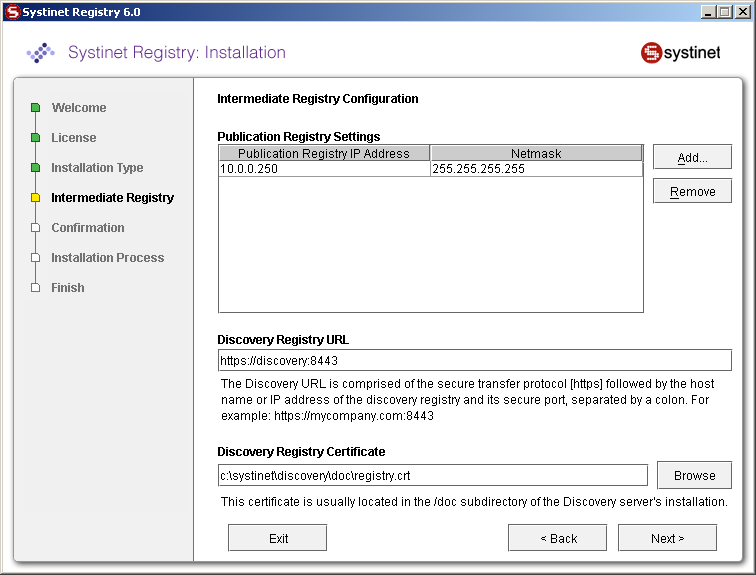
- Publication Registry IP address
The IP address allowed to connect to this discovery registry.
- Netmask
A netmask is a 32-bit mask used to divide an IP address into subnets and specify the network's available hosts.
The default netmask of 255.255.255.255 indicates that publication registry may be connected only from the IP address specified in Publication Registry IP address
- Discovery Registry URL
Enter the HTTPS URL of the discovery registry. Note that HTTP (nonsecure) connections between the publication and discovery registry are not allowed.
- Discovery Registry Certificate
Browse for or type the fully qualified path to the certificate file from Discovery Registry. This file is located on the discovery installation directory at REGISTRY_HOME/doc/registry.crt.
Continue with standalone installation as described in Server Settings.

